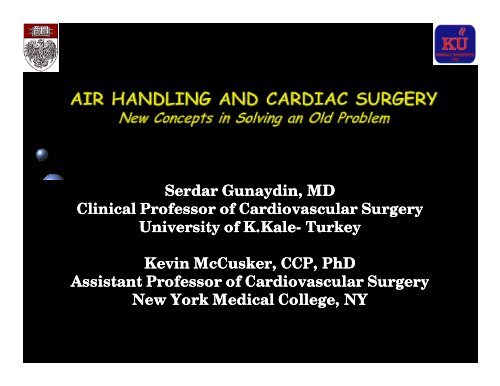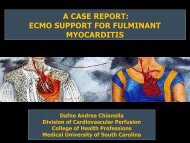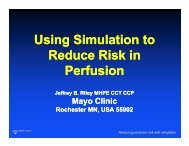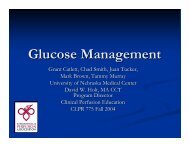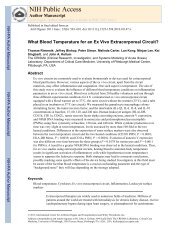PowerPoint Presentation (PDF) - Perfusion.com
PowerPoint Presentation (PDF) - Perfusion.com
PowerPoint Presentation (PDF) - Perfusion.com
Create successful ePaper yourself
Turn your PDF publications into a flip-book with our unique Google optimized e-Paper software.
Serdar Gunaydin, MD<br />
Clinical Professor of Cardiovascular Surgery<br />
University of K.Kale- Turkey<br />
Kevin McCusker, CCP, PhD<br />
Assistant Professor of Cardiovascular Surgery<br />
New York Medical College, NY
Air handling: Revisit<br />
Definitions, , types and tissue effects of macroeboli and<br />
microemboli<br />
Localization, sources and prevention of air in cardiac surgery<br />
Detection & Quantification of Air Particles<br />
Evidence based scientific research on air handling<br />
Our studies<br />
‣Air handling & Cardiac surgery. AmSECT Td Today, Nov, 2008<br />
‣Clinical<br />
Evaluation Of Minimized Extracorporeal Circulation<br />
in High<br />
Risk<br />
Coronary Revascularizat<br />
zation. <strong>Perfusion</strong> 2009<br />
‣The<br />
Impact of the Intensity of Microemboli on Postoperative Neurocognitive<br />
Out<strong>com</strong>e in Coronary Revascularization<br />
Novel<br />
approcah to air handling in cardiac surgery
Although modern techniques of Whereas the incidence of adverse<br />
cardiopulmonary bypass and<br />
better circuit designs have<br />
patient out<strong>com</strong>e attributable to<br />
gross air embolism was once<br />
minimized the fatal cases of<br />
every 2500 cases in the 1970s, the<br />
massive air embolism, recent<br />
incidence in the 1990s has fallen to<br />
investigations suggest that<br />
once every 30 000 cases according<br />
systemic air microembolization<br />
to the most recent national survey<br />
derived from extracorporeal<br />
Previous studies have reported<br />
sources still represents a<br />
that between 6% and 9% of the<br />
<strong>com</strong>mon problem during<br />
total number of emboli detected<br />
conventional CPB<br />
during CABG occur during the<br />
High numbers of air<br />
onset of CPB<br />
microemboli are one factor<br />
<br />
These embolic signals are assumed<br />
contributing to a reported 50-<br />
to represent air bubbles delivered<br />
70% rate of cognitive deficits<br />
into the systemic circulation as a<br />
one week after CABG and 30%<br />
result of air retained in the<br />
rate of long-term<br />
<strong>com</strong>ponents of the extracorporeal<br />
neuropsychologic impairment<br />
circuit
Recent design improvements and current<br />
strategies t of CPB in some instances have not been<br />
proven to reduce<br />
•Vacuum-assisted<br />
and may, in<br />
venous<br />
fact, increase the<br />
risk of gross drainage<br />
air embolism during CPB<br />
• Drug injection •Low-prime perfusion circuits<br />
•Aortic cannula •Carbon type dioxide and placement flooding of<br />
•Internal properties the operative of oxygenator field<br />
and filters<br />
•Levels of vacuum (
Cardiovascular function is affected by the <strong>com</strong>pressible air causing obstruction to<br />
right ventricular ejection at the level of the pulmonary outflow tract<br />
Slower infusions of air be<strong>com</strong>e trapped at the level of the pulmonary arterioles<br />
causing pulmonary arterial hypertension and subsequent right ventricular failure<br />
The effect of microbubbles entering the pulmonary arterioles gradually is not only to<br />
obstruct flow but, in addition, neutrophils are attracted to the network of fibrin, red<br />
blood cells, fat globules and platelets that build up around the bubble<br />
The ultrastructural damage that results from this leads to increased basement<br />
membrane permeability and, ultimately, to pulmonary edema<br />
Sufficient pressure builds up on the right side of the heart to push gas through the<br />
pulmonary circulation to the left atrium. Any increase in pulmonary artery pressure<br />
will favour the transfer of air into arterial circulation
Air handling: Revisit<br />
Definitions, , types and tissue effects of macroeboli and<br />
microemboli<br />
Localization, sources and prevention of air in cardiac surgery<br />
Detection & Quantification of Air Particles<br />
Evidence based scientific research on air handling<br />
Our studies<br />
‣Air handling & Cardiac surgery. AmSECT Td Today, Nov, 2008<br />
‣Clinical<br />
Evaluation Of Minimized Extracorporeal Circulation<br />
in High<br />
Risk<br />
Coronary Revascularizat<br />
zation. <strong>Perfusion</strong> 2009<br />
‣The<br />
Impact of the Intensity of Microemboli on Postoperative Neurocognitive<br />
Out<strong>com</strong>e in Coronary Revascularization<br />
Novel<br />
approcah to air handling in cardiac surgery
We can divide emboli into macro and micro categories according to size,<br />
the former occluding flow in arteries 200 μm or greater in diameter and<br />
the latter, in smaller arteries, arterioles, and capillaries<br />
Distinction on the basis of size is no guide to the <strong>com</strong>position of emboli<br />
Such a distinction may reflect different clinical manifestations:<br />
• A single macroembolus might result in hemiplegia, but a solitary microembolus is<br />
unlikely to have a noticeable effect except in very susceptible tissue such as the<br />
retina<br />
•Clinical effects of microemboli should arise only when these emboli are numerous<br />
and can be expected to present a diffuse pattern of CNS injury rather than a focal<br />
deficit
GAS BUBBLES<br />
BIOLOGIC AGGREGATES<br />
Gaseous emboli consist INORGANIC of air or<br />
DEBRIS<br />
Emboli of biologic aggregates including<br />
anesthetic gas, particularly Embolizationb nitrous oxide of fragments of polyvinyl thrombus, l chloride<br />
platelet aggregates, and fat are<br />
The gas in a bubble tubing flowing exposed in the to the roller pump<br />
also<br />
and<br />
in<br />
of<br />
a<br />
silicone<br />
dynamic state, with the blood<br />
bloodstream is in dynamic antifoam equilibrium have been described,but<br />
allowing<br />
current<br />
growth or dispersal according to<br />
with the same gas dissolved manufacturing the standards have substantially<br />
prevailing conditions<br />
plasma, and a bubble reduced will therefore these hazards grow<br />
Dispersal is dependent on biochemical as<br />
or shrink according to Many the partial studies pressure of experimental microembolism<br />
well as physical mechanisms and<br />
of the gas in solution, have which used is largely glass and latex microspheres<br />
may<br />
of<br />
be<br />
known<br />
slower than for bubbles, although<br />
dependent on temperature size, and the tissue effects of these<br />
experimental<br />
artificial<br />
microvascular occlusions with<br />
platelet aggregates showed reperfusion<br />
Bubbles are more likely microemboli to form and are consequently well<br />
within 20 minutes<br />
grow during the rewarming documented<br />
phase of CPB<br />
Solid emboli can migrate a short<br />
Platelets<br />
distance<br />
contain vasoactive substances and<br />
Because the pressure in a bubble tends<br />
downstream after initial impact and<br />
can<br />
occlusion<br />
also cause<br />
of<br />
endothelial<br />
a<br />
injury<br />
to force the gas into solution and is<br />
vessel but cannot disperse<br />
Thrombi can arise from within the heart,<br />
inversely proportional to the radius,<br />
most <strong>com</strong>monly from the left atrial<br />
small bubbles are inherently unstable in<br />
appendage or a left ventricular aneurysm, or<br />
blood when less than 10 μm in diameter<br />
from the CPB circuit if heparinization is<br />
Similar considerations apply when a<br />
Inadequate heparin may contribute to fat<br />
bubble embolus occludes a blood vessel;<br />
embolism by stimulating endothelial<br />
dispersal seems to occur rapidly,<br />
lipoprotein p lipase, and denaturation of<br />
although endothelial injury and endorgan<br />
damage may persist<br />
plasma lipids, but the principal source of<br />
proteins during CPB may also precipitate<br />
cholesterol embolism is probably from largevessel<br />
atherosclerotic plaques
Air handling: Revisit<br />
Definitions, , types and tissue effects of macroeboli and<br />
microemboli<br />
Localization, sources and prevention of air in cardiac surgery<br />
Detection & Quantification of Air Particles<br />
Evidence based scientific research on air handling<br />
Our studies<br />
‣Air handling & Cardiac surgery. AmSECT Td Today, Nov, 2008<br />
‣Clinical<br />
Evaluation Of Minimized Extracorporeal Circulation<br />
in High<br />
Risk<br />
Coronary Revascularizat<br />
zation. <strong>Perfusion</strong> 2009<br />
‣The<br />
Impact of the Intensity of Microemboli on Postoperative Neurocognitive<br />
Out<strong>com</strong>e in Coronary Revascularization<br />
Novel<br />
approcah to air handling in cardiac surgery
Major Significance<br />
<br />
<br />
<br />
<br />
<br />
<br />
<br />
Atrial fibrillation<br />
Valvular (mitral)<br />
stenosis<br />
Myocardial infarction<br />
Thrombus in left<br />
ventricle<br />
Infective endocarditis<br />
Myxoma in the left<br />
atrium<br />
Dilated<br />
cardiomyopathy<br />
Minor Significance<br />
<br />
<br />
<br />
<br />
<br />
Mitral valve prolapse<br />
Patent foramen ovale<br />
Aneurysm of atrial<br />
septum<br />
Valvular (aortic<br />
aortic, mitral)<br />
calcifications<br />
Prosthetic heart valve
Atherosclerotic artery Cardiopulmonary<br />
disease<br />
bypass<br />
Carotid stenosis<br />
<br />
Carotid<br />
Intracranial artery<br />
endarterectomy<br />
stenosis<br />
<br />
Angiography<br />
Aortic arch plaques<br />
<br />
Percutaneous<br />
Dissection of carotid<br />
transluminal<br />
arteries<br />
angioplasty<br />
Aortic aneurysm
Careful dearinig of intravenous catheters and CPB circuit<br />
Incorporation p of air detector and bubble traps in intravenous<br />
catheters and in the CPB circuit<br />
Incorporation of arterial catheter filter<br />
Constant attention to the oxygenator blood level<br />
Incorporation of blood level sensor/shut off in the oxygenator design<br />
Testing of vents and suckers in saline before CPB<br />
Check of integrity and direction of perfusion catheters<br />
Immediate cessation of pump and inspection on any abnormal noise<br />
Avoidance of traffic around the perfusion catheters<br />
Secure fixation of the oxygenator<br />
Adequate vent on the oxygenator to avoid pressurization
Air handling: Revisit<br />
Definitions, , types and tissue effects of macroeboli and<br />
microemboli<br />
Localization, sources and prevention of air in cardiac surgery<br />
Detection & Quantification of Air Particles<br />
Evidence based scientific research on air handling<br />
Our studies<br />
‣Air handling & Cardiac surgery. AmSECT Td Today, Nov, 2008<br />
‣Clinical<br />
Evaluation Of Minimized Extracorporeal Circulation<br />
in High<br />
Risk<br />
Coronary Revascularizat<br />
zation. <strong>Perfusion</strong> 2009<br />
‣The<br />
Impact of the Intensity of Microemboli on Postoperative Neurocognitive<br />
Out<strong>com</strong>e in Coronary Revascularization<br />
Novel<br />
approcah to air handling in cardiac surgery
IN VIVO<br />
IN VITRO<br />
IN VITRO<br />
Ultrasound<br />
Histopathology<br />
On-line IN VIVO<br />
Blood<br />
detection<br />
Sampling<br />
of echogenic In early material studies, in Hill the examined tubing of the extracorporeal brains circuit was first<br />
reported Retinal by Studies and Austen Other by and Swank End-Organ Howry of 133 in the patients Studies in1950s 1965<br />
who on the died filtration after an of<br />
open<br />
Doppler The retina stored ultrasound provides blood has<br />
in an heart relation excellent operation. to opportunity blood Fat transfusion embolism to study led was the to<br />
the cerebrovascular<br />
also microcirculation been the used development to detect in vivo<br />
emboli most of the <strong>com</strong>mon in screen the carotid finding filtration arteries and method<br />
occurred and the in<br />
middle cerebral arteries<br />
Continuous It also for provides the standing-wave detection ideal nearly of model microaggregates (non-Doppler) all patients for the study ultrasound in of blood<br />
embolic has events a very because high detection of the absence rate for solid<br />
microparticles<br />
of arteriolar<br />
<br />
The pressure collaterals required More and the to recent clear force demarcation studies blood at have a given of identified ischemic areas<br />
Although Quantification flow it is rate technically of through the platelet-fibrin<br />
extent possible a screen of retinal filter for microaggregates ultrasonic ischemia of given methods pore was achieved size<br />
in canine<br />
to differentiate by digital image between analysis gaseous and<br />
solid of the emboli ischemic was by measured<br />
spectral areas<br />
retinal vessels after CPB, and these<br />
analysis, this It should has not be been microaggregates noted feasible that both as an microaggregates on-line have been technique<br />
associated with<br />
and<br />
More importantly, gaseous microbubbles calibration microfocal are ultrasound ischemic neuronal<br />
inherently for unstable<br />
quantitative injury. Use<br />
studies presents serious<br />
difficulties, entities particularly of a specialized histochemical technique<br />
in thein blood blood<br />
and can be altered by foreign<br />
Conversion has revealed cerebral arteriolar and<br />
surfaces; of detected hence, signals any manipulation<br />
into ``counts'' of blood<br />
depends on software programming variables, and<br />
it is unclear<br />
capillary lesions after CPB<br />
samples for measurement has Ma high probability<br />
whether an Careful histopathology still provides<br />
of increase altering such in signal emboli<br />
amplitude reflects an increase in the number or the size of emboli<br />
evidence of embolic problems in the CNS<br />
after cardiac surgical interventions
Online devices employ ultrasound<br />
technology to detect individual gaseous<br />
microemboli in blood flowing through an<br />
extracorporeal circuit<br />
The unit has demonstrated count rates<br />
exceeding 1000 emboli per second, with<br />
diameters from 10 microns to the connector<br />
diameter, and with flow rates between 2.0<br />
L/minute and 6.0 L/minute<br />
Up to three sensors may be placed<br />
• venous inlet<br />
• in between bubble trap and oxygenator<br />
• on arterial line after arterial filter
The image cannot be displayed. Your <strong>com</strong>puter may not have enough memory to open the image, or the image may have been corrupted. Restart your <strong>com</strong>puter, and then open the file again. If the red x still appears, you may have to delete the image and then insert it again.
Air handling: Revisit<br />
Definitions, , types and tissue effects of macroeboli and<br />
microemboli<br />
Localization, sources and prevention of air in cardiac surgery<br />
Detection & Quantification of Air Particles<br />
Evidence based scientific research on air handling<br />
Our studies<br />
‣Air handling & Cardiac surgery. AmSECT Td Today, Nov, 2008<br />
‣Clinical<br />
Evaluation Of Minimized Extracorporeal Circulation<br />
in High<br />
Risk<br />
Coronary Revascularizat<br />
zation. <strong>Perfusion</strong> 2009<br />
‣The<br />
Impact of the Intensity of Microemboli on Postoperative Neurocognitive<br />
Out<strong>com</strong>e in Coronary Revascularization<br />
Novel<br />
approcah to air handling in cardiac surgery
Diameter of<br />
Volume of<br />
No. of<br />
Each Bubble Each Bubble Bubbles<br />
Total Volume<br />
Surface Area<br />
of Each<br />
Bubble<br />
Total Surface<br />
Area<br />
1 cm = 10 mm 05mL 0.5 1 05mL 0.5 314cm 3.14 2 314cm 3.14 2<br />
0.1 cm = 1 mm 0.5 µL 1,000 0.5 mL 3.14 mm 2 31.4 cm 2<br />
0.01 cm = 100 µm 5 x 10 -4 µL 1,000,000 0.5 mL 31,400 µm 2 314 cm 2<br />
0.001 cm = 10 µm 5 x 10 -7 µL 1,000,000,000 0.5 mL 314 µm 2 3,140 cm 2
Cardiac<br />
Complication No. of Patients No. of Embolic Signals p Value a<br />
Major 7 392 ...<br />
Minor 27 183 0.04<br />
None 48 153 0.01<br />
a One-way analysisof variance, relative to major cardiac <strong>com</strong>plications.<br />
i
Length of Stay (days) a<br />
No. of Embolic Signals All Patients (n = 79) b Neurologic Complications (n = 73) b<br />
Patients Without Major Cardiac or<br />
0–100 8.6 ± 2.7 (n = 40) 8.0 ± 2.8 (n = 37)<br />
101–300 13.5 ± 6.9 (n = 23) 13.7 ± 7.0 (n = 22)<br />
301–500 16.3 ± 4.8 (n = 10) 15.9 ± 5.1 (n = 9)<br />
>500 55.8 ± 9.7 (n = 6) 44.8 ± 11.3 (n = 5)<br />
a<br />
Data are shown as mean ± standard deviation. b Excludes deaths.
Air handling: Revisit<br />
Definitions, , types and tissue effects of macroeboli and<br />
microemboli<br />
Localization, sources and prevention of air in cardiac surgery<br />
Detection & Quantification of Air Particles<br />
Evidence based scientific research on air handling<br />
Our studies<br />
‣Air handling & Cardiac surgery. AmSECT Td Today, Nov, 2008<br />
‣Clinical<br />
Evaluation Of Minimized Extracorporeal Circulation<br />
in High<br />
Risk<br />
Coronary Revascularizat<br />
zation. <strong>Perfusion</strong> 2009<br />
‣The<br />
Impact of the Intensity of Microemboli on Postoperative Neurocognitive<br />
Out<strong>com</strong>e in Coronary Revascularization<br />
Novel<br />
approcah to air handling in cardiac surgery
PROJECT DIRECTOR: S. GUNAYDIN, MD, PhD<br />
CONSULTANTS: K. McCUSKER, CCP, PhD; T. GOURLAY, PhD<br />
MULTI-CENTER: : T. TEZCANER, MD, Y. ZORLUTUNA, MD<br />
CHIEF PERFUSIONIST: : T.SARI, Msc<br />
CELL CULTURE-PHAGOCYTIC INDEX: M.A.ONUR, PhD, A.GURPINAR,PhD;<br />
P.ATASOY, MD<br />
SCANNING ELECTRON MICR: M.F.SARGON, MD,PhD<br />
GENETICS : AYSEN G OZCAN, MD, PhD<br />
BIOCHEMISTRY: NECATI BINGOL, PhD<br />
University i of K.Kale-Turkey;<br />
NY Medical College, NY; University i of Strathclyde-Scotland<br />
Scotland<br />
Bayindir Hospital, Hacettepe University/ TURKEY
CLINICAL EVALUATION OF MINIMIZED EXTRACORPOREAL CIRCULATION IN<br />
HIGH RISK CORONARY REVASCULARIZATION<br />
Impact on air handling, inflammation, hemodilution and myocardial function<br />
SERDAR GUNAYDIN, MD 1 ; TAMER SARI, MSc 2 ; KEVIN McCUSKER, CCP, PhD 3 ;<br />
UWE SCHONROCK, CCP 4 ; YAMAN ZORLUTUNA, MD 2<br />
1 University of Kirikkale, TURKEY; 2 Bayindir Hospital, TURKEY;<br />
3 Portsmouth Regional Hospital, NH-USA;<br />
Klinikum Braunschweig-GERMANY<br />
4<br />
<strong>Perfusion</strong> 2009
PATIENTS & METHODS<br />
Over a ten-month period, 40 patients (Euroscore 6+) undergoing<br />
coronary revascularization were prospectively randomized (closed<br />
envelope allocation) to one of the two perfusion protocols with the<br />
investigators blinded to the allocation (N=20):<br />
Group 1: Mini-CPB (Rocsafe MPC, Terumo, USA)<br />
Group 2: CECC (Capiox SX18, Terumo, USA)<br />
Blood Sampling<br />
Baseline: After induction of anesthesia (before administration of<br />
heparin) (T1)<br />
Thromboelastography (TEG) control: After heparin administration<br />
before CPB (T2)<br />
On CPB: 15 min. after initiation of CPB (T3)<br />
Off CPB: Before cessation of CPB (before protamine infusion) (T4)<br />
Protamine: 15 min. after reversal with protamine (T5)<br />
ICU: First postoperative day at 8:00 a.m. (T6)
GME (emboli.sec -1 ) Group 1<br />
Group 2<br />
p<br />
(Mini-CPB)<br />
(CECC)<br />
T3 T4 T3 T4 NS<br />
Venous (inlet) 32.8±5.3 94.2±8.7 40.4±4.7 107.3±11 NS<br />
Bubble trap-oxygenator 22.3±4.1 44.3±6 29.3±4.7 51.4±7.1 NS<br />
Arterial (outlet) 12.6±3.6 18.3±4.6 17.5±4 22.7±4.5 NS
14<br />
CKMB<br />
12<br />
*<br />
10<br />
L-1<br />
ng.m<br />
8<br />
6<br />
Mini-CPB<br />
CECC<br />
4<br />
2<br />
0<br />
Pre-CPB<br />
Post CPB
RFI % Ch hange<br />
25<br />
20<br />
15<br />
10<br />
5<br />
0<br />
-5<br />
Neutrophil CD11b/CD18<br />
*<br />
*<br />
T1 T3 T4 T5 T6<br />
Mini-CPB<br />
CECC
Utley Award Winner:<br />
Clinical Performance and<br />
Bio<strong>com</strong>patibility of Novel Hyaluronan-<br />
Coated Heparin-Free Extracorporeal<br />
Circuits in High-Risk Patients<br />
Undergoing Coronary Revascularization<br />
Serdar Gunaydin , Kevin McCusker,<br />
Tamer Sari, Ibrahim Ucar, Cemi Karabay,<br />
and Cem Yorgancioglu
In a four-month period, 40 patients (Euroscore 6+ ) were prospectively<br />
randomized to one of the two perfusion protocols (N=20)<br />
Group 1: Hyaluronan-coated, heparin free ECC<br />
(Vision-GBS-HF, Gish, Ca)<br />
Group 2: Uncoated control<br />
(Vision-HFO, Gish, Ca)<br />
<br />
<br />
The primary endpoints of this study were to evaluate the air<br />
handling capacity and to qualify <strong>com</strong>fort and safety level of novel<br />
ECC in high risk CABG cases<br />
Secondary endpoints were to document any differences in contact<br />
activation- inflammatory response, hemolysis, hemodilution,<br />
myocardial protection and clinical out<strong>com</strong>e
GME (emboli.sec<br />
- 1 )<br />
Group 1<br />
(GBS-COATED)<br />
Group 2<br />
(CONTROL)<br />
p<br />
T3<br />
T4<br />
T3<br />
T4<br />
Venous (inlet) 32.8±5.3<br />
94.2±8.7<br />
40.4±4.7<br />
4.7 107.3±11<br />
11 NS<br />
Bubble trap-oxygenator<br />
22.3±4.1<br />
44.3±6 29.3±4.7<br />
51.4±7.1<br />
NS<br />
Arterial (outlet) 12.6±3.6<br />
18.3±4.6<br />
17.5±4 22.7±4.5<br />
NS
The Impact of the Intensity of Microemboli on<br />
Postoperative Neurocognitive Out<strong>com</strong>e in<br />
Coronary Revascularization<br />
Serdar Gunaydin, Kevin McCusker, Tamer Sari,<br />
Yaman Zorlutuna
Microemboli (ME) to cerebral circulation occur<br />
during CPB and can contribute to<br />
postoperative neurocognitive dysfunction<br />
We examined the correlation of the intensity of<br />
intraoperative microembolic signals with<br />
respect to inflammatory response,<br />
postoperative brain perfusion and<br />
neuropsychological testing in high-risk patients<br />
undergoing cardiac surgery
Over a two- year period ,ME activity was monitored simultaneously<br />
during the first and last 15 min. of extracorporeal circulation by fixedbeam<br />
ultrasonic imaging device detecting and sizing at three locations<br />
(EDAC, Luna Innovations, Roanoke, VA) and documenting gparticles<br />
>30 microns in 150 Euroscore 6+ patients<br />
Patients were randomized into three groups:<br />
‣ Group 1: those where more than 30 emboli/sec were detected (N=42)<br />
‣ Group 2: those where 10-30 emboli/sec were detected (N=53)<br />
‣ Group 3: those where less than 10 emboli/sec(N=55) were detected<br />
<br />
<br />
<br />
Eight cognitive domains and a global cognitive score, as well as<br />
depressive and subjective symptoms were analyzed<br />
Patients underwent Tc99m HMPAO brain SPECT imaging a week<br />
before and after surgery<br />
Serum lactate, t interleukin-6 (IL-6),C3a,tumor necrosis factor alpha<br />
(TNF-alpha), D-dimer and CRP levels were measured. CD11b/CD18<br />
expressions were determined by flow cytometry
Group 1 had a 33.3% 3% (N=14) rate of neurological<br />
dysfunction (stroke,<strong>com</strong>a, delirium or aberrant<br />
behavior) versus 9.4% (Group 2, N=5) and 5.4%<br />
(Group3, N=3),detected by neurocognitive<br />
evaluation(p
Group 1<br />
Group 2<br />
Group 3<br />
(>30emb/s, (10-30 emb/s (
ME intensity is well correlated with<br />
postoperative neurocognitive out<strong>com</strong>e in high<br />
risk patients undergoing CABG<br />
Early detection of ME can catch accidents and<br />
errors in technique, and allow the surgical team<br />
to correct these errors before the problem<br />
be<strong>com</strong>es serious
We have designed studies for the evaluation of air handling<br />
characteristics of minicircuits vs. conventional, air handling evaluation of<br />
ECC and neurocognitive out<strong>com</strong>e following high-risk CABG<br />
We have incorporated ultrasound detection system with cerebral<br />
oximetry, BIS, TCD, proinflammatory-hematologic l parameters, indicators<br />
of myocardial preservation, psychological testing and clinical out<strong>com</strong>e<br />
Initial results are promising for a perfect correlation with different<br />
monitoring devices, inflammation and psychological testing<br />
Online detection systems alert significantly before studied monitoring<br />
technologies<br />
<br />
We believe we have obtained revolutionary data of air embolism of<br />
significantly higher quantity than expected, based on previous in vitro<br />
studies<br />
Ongoing Studies:<br />
‣ Open vs. closed circuits<br />
‣ Pulsatile vs. non-pulsatile flow<br />
‣ Comparison of characteristics of extracorporeal circuits from different<br />
manufacturers<br />
‣ Air generation in various procedures
Air handling: Revisit<br />
Definitions, , types and tissue effects of macroeboli and<br />
microemboli<br />
Localization, sources and prevention of air in cardiac surgery<br />
Detection & Quantification of Air Particles<br />
Evidence based scientific research on air handling<br />
Our studies<br />
‣Air handling & Cardiac surgery. AmSECT Td Today, Nov, 2008<br />
‣Clinical<br />
Evaluation Of Minimized Extracorporeal Circulation<br />
in High<br />
Risk<br />
Coronary Revascularizat<br />
zation. <strong>Perfusion</strong> 2009<br />
‣The<br />
Impact of the Intensity of Microemboli on Postoperative Neurocognitive<br />
Out<strong>com</strong>e in Coronary Revascularization<br />
Novel<br />
approcah to air handling in cardiac surgery
Do we really need air detection<br />
and count in our clinical<br />
practice?<br />
Can we have better clinical<br />
l<br />
out<strong>com</strong>e by better air<br />
handling?
INTERVENTION<br />
%DECREASE OF GME DETECTION<br />
Aortic and venous cannulation 26.2%<br />
Controlling venous return 52.4%<br />
Reservoir level correction 18.7%<br />
Drug administration 69%<br />
Management of temperature gradient 41%<br />
Alerting the need of myocardial or<br />
ventilatory support in post-CPB<br />
period due to significant air embolism<br />
QA for different centers and<br />
perfusionists<br />
i 25%<br />
How much GME is important<br />
t<br />
clinically?
The total volume of gas tolerated in humans is<br />
hard to estimate<br />
Small volumes can lead to symptoms, particularly<br />
if paradoxical air embolism ensues, potentially<br />
causing cardiovascular and/or neurological<br />
problems<br />
Volumes between 100-300 ml can be fatal<br />
(approximately 1 mg.kg -1 )<br />
This volume is relevant, since it has been shown<br />
that 100 ml of air per second can be entrained<br />
through a 14 gauge cannula with only 5 cm<br />
pressure gradient
Diameter of<br />
Volume of<br />
No. of<br />
Each Bubble Each Bubble Bubbles<br />
Total Volume<br />
Surface Area<br />
of Each<br />
Bubble<br />
Total Surface<br />
Area<br />
1 cm = 10 mm 05mL 0.5 1 05mL 0.5 314cm 3.14 2 314cm 3.14 2<br />
0.1 cm = 1 mm 0.5 µL 1,000 0.5 mL 3.14 mm 2 31.4 cm 2<br />
0.01 cm = 100 µm 5 x 10 -4 µL 1,000,000 0.5 mL 31,400 µm 2 314 cm 2<br />
0.001 cm = 10 µm 5 x 10 -7 µL 1,000,000,000 0.5 mL 314 µm 2 3,140 cm 2
We believe data obtained via novel air<br />
detection studies will change the future of<br />
cardiac surgery<br />
The amount of air tolerated by humans and the<br />
definition of post-CPB neurologic dysfunction<br />
will be redescribed and, following large<br />
population studies, we can start discussing the<br />
underestimation of air embolism in patients<br />
suffering postoperative low cardiac output<br />
syndrome, renal failure or stroke


